|
|
Electric-field Assisted Joining Technology for the Ceramics Materials: Current Status and Development Trend
LIU Yan, ZHANG Keying, LI Tianyu, ZHOU Bo, LIU Xuejian, HUANG Zhengren
2023 Vol. 38 (2): 113–124
 Abstract
Abstract(
665 )
 HTML
HTML(
146)
 PDF
PDF(7770KB)(
737
)
Ceramic materials are widely used in aerospace, medicine and energy transportation concerned for their excellent over-all mechanical and chemical properties, such as corrosion resistance, high temperature resistance and oxidation resistance. Especially, joining ceramic materials themselves and connecting them with metals are of great significance for the practical engineering applications. Compared with traditional joining technology, electric-assisted joining technology possesses a variety of advantages, such as low temperature and short time, owing to the special influence of the electric field on some ceramic materials. This paper focuses on the development of the electric-field assisted joining technologies of ceramics and ceramic matrix composites, and summarizes their research status in recent years. From the views of joining mechanism, typical interface microstructure and joint strength and influencing factors, the electric-field assisted diffusion bonding (FDB), spark plasma sintering (SPS) joining, and the new low-temperature rapid flash joining (FJ) are reviewed. Moreover, the applicable scope and limitations of different electric-field assisted joining technologies are expounded. In addition, the development trend of the electric-field assisted joining technology of ceramic materials is prospected.

|
|
|
Current Status and Development Trend of Cold Sintering Process
FENG Jingjing, ZHANG Youran, MA Mingsheng, LU Yiqing, LIU Zhifu
2023 Vol. 38 (2): 125–136
 Abstract
Abstract(
1422 )
 HTML
HTML(
88)
 PDF
PDF(5021KB)(
1151
)
Densification of ceramic materials by conventional sintering process usually requires a high temperature over 1000 ℃, which not only consumes a lot of energy, but also forces some ceramic materials to face challenges in phase stability, grain boundary control, and co-firing with metal electrodes. In recent years, an extremely low temperature sintering technique named cold sintering process (CSP) was proposed, which can reduce the sintering temperature to below 400 ℃, and realize the rapid densification of ceramic materials through the dissolution- precipitation process of ceramic particles by using the transient solvent in liquid phase and uniaxial pressure. The advantages of CSP, including low sintering temperature and short sintering time, have attracted extensive attention from researchers, since it was firstly reported in 2016. At present, CSP has been applied to the sintering of nearly 100 kinds of ceramics and ceramic-matrix composites, involving dielectric materials, semiconductor materials, pressure-sensitive materials, and solid-state electrolyte materials. This paper firstly introduces the low-temperature sintering techniques’ development history, process and densification mechanism. Then, application of CSP in the field of ceramic materials and ceramic-polymer composites is summarized. Based on differences of solubility, application of CSP mainly on Li2MoO4 ceramics, ZnO ceramics, BaTiO3 ceramics, and their composites preparations are introduced. Auxiliary effect of the transient solvent on cold sintering process is emphatically analyzed. Moreover, the high pressure issue in the cold sintering process and the possible solutions are discussed. At last, future development trend of cold sintering process is prospected.
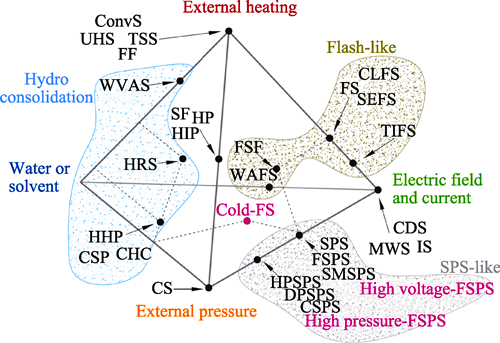
|
|
|
Research Progress of Polymer-based Multilayer Composite Dielectrics with High Energy Storage Density
XIE Bing, CAI Jinxia, WANG Tongtong, LIU Zhiyong, JIANG Shenglin, ZHANG Haibo
2023 Vol. 38 (2): 137–147
 Abstract
Abstract(
946 )
 HTML
HTML(
61)
 PDF
PDF(26256KB)(
1032
)
Film capacitors are the core electronic components of modern power devices and electronic equipment. However, due to the low dielectric constant, it is difficult to obtain high energy storage density (effective energy storage density or discharged energy density) for present film capacitors, leading to a large device size and high application cost. To improve the energy storage density of film capacitors, a nanocomposite approach is an effective strategy via combining high dielectric constant of the ceramic nanoparticles with high breakdown strength of the polymer matrix. Nevertheless, for single-layer structure of 0-3 polymer/ceramic composites, the dielectric constant and breakdown strength are difficult to be effectively enhanced at the same time, which limits the further improvement of energy storage density. To solve this contradiction, researchers have combined the composite film with high dielectric constant and high breakdown strength in a superposition to prepare 2-2 type multilayer composite dielectrics, which can achieve synergistic regulation of polarization strength and breakdown strength to obtain high energy storage density. The optimization of electric field distribution and the synergistic regulation of dielectric constant and breakdown strength can be achieved through mesoscopic and microstructural modulation of multilayer composite dielectrics. In this paper, the research progress of multilayer polymer-based composite dielectrics including ceramic/polymer multilayer structure and all-organic polymer multilayer structure in recent years is reviewed. Effect of multi-layer structure control strategy on the improvement of energy storage performance is emphasized. Moreover, enhancement mechanism of energy storage performance of polymer-based multilayer structure composite dielectric is summarized. Finally, challenges and development directions of multilayer composite dielectrics are discussed.
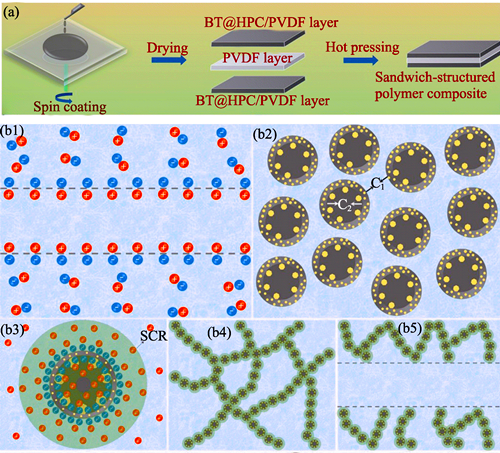
|
|
|
Effects of Al3+ Doping on the Structure and Electrical Transport Property of La0.8Sr0.2Mn1-xAlxO3
ZHANG Aimei, ZHU Jiajia, FANG Tiancheng, PAN Xixi
2023 Vol. 38 (2): 148–154
 Abstract
Abstract(
407 )
 HTML
HTML(
17)
 PDF
PDF(950KB)(
449
)
As a colossal magnetoresistance material, the perovskite manganese oxide La1–xSrxMnO3 (LSMO) has broad application prospects in magnetic sensors and other fields. However, it is difficult to obtain a significant colossal magnetoresistance effect at a low magnetic field at room temperature. To improve its magnetoresistance effect and transition temperature, La0.8Sr0.2Mn1–xAlxO3 (0≤x≤0.25) (LSMAO) polycrystalline samples were prepared by traditional solid-state reaction method in present work. Effects of Al3+ doping on the electrical transport property and magnetoresistance of LSMO were systematically analyzed. The X-ray diffraction (XRD) results indicate that all samples crystallize in a single rhombohedral structure with the space group of $\text{R}\bar{3}\text{C}$. Result of electrical transport property shows that resistivity of the samples increases exponentially with the increment of Al3+ doping amount, and the metal-insulator transition temperature is increased by an external magnetic field. This phenomenon may be attributed to dilution of the Mn3+/Mn4+ ions network by Al3+, which increases the magnetic disorder but reduces the number of carriers. In addition, the conduction mechanism of LSMAO ceramics change from the small polaron hopping model (SPH) to the variable range hopping model (VRH) after doping of Al3+, reflecting that the non-magnetic Al3+ weakens the carrier exchange between the ferromagnetic clusters. As a result, the thermally activated neighbor transition of small polarons is suppressed. Magnetoresistance effect of LSMAO is enhanced from 21.03% to 59.71% with x increasing from 0 to 0.25, which proves that the doping of Al3+can effectively enhance the magnetoresistance effect of LSMAO.

|
|
|
Evolution of Electric Field and Breakdown Damage Morphology for Flexible PDMS Based Dielectric Composites
CHEN Lei, HU Hailong
2023 Vol. 38 (2): 155–162
 Abstract
Abstract(
525 )
 HTML
HTML(
18)
 PDF
PDF(11883KB)(
510
)
Compared with other electric energy storage devices, dielectric capacitors made of dielectric composites have great advantages in fast charging and discharging capacity with high power density. A dilemma of improving the energy density of dielectric composites and synchronous optimizing their breakdown performance is becoming an intriguing research direction. To further adjust the contradiction between dielectric constant and dielectric breakdown performance, here a finite element numerical simulation based on dielectric breakdown model (DBM) was proposed to study the effect of the distribution of inorganic fillers on the electric field and breakdown damage morphology in flexible polydimethylsiloxane(PDMS) based dielectric composite system. The results show that a large dielectric difference is observed between filler and matrix, which indicates that polymer matrix with a large dielectric constant or inorganic filler with a small dielectric constant can realize reducing the size of the high electric field area at the interface and improving the breakdown resistance of the material. This study further reveals that the more dispersed structure of inorganic fillers, the more likely its dendritic damage channels tend to branch, indicating that this situation is conducive to the increase of damage sites of dielectric breakdown dendritic damage channels, the decrease of damage rate, and the improvement of breakdown resistance of materials. All above data demonstrate that this study provides certain guidance for the development of organic-inorganic dielectric composites with both high energy storage and excellent breakdown performance.

|
|
|
Effect of Surface Treatment of n-type Bi2Te3-based Materials on the Properties of Thermoelectric Units
HUA Siheng, YANG Dongwang, TANG Hao, YUAN Xiong, ZHAN Ruoyu, XU Zhuoming, LYU Jianan, XIAO Yani, YAN Yonggao, TANG Xinfeng
2023 Vol. 38 (2): 163–169
 Abstract
Abstract(
369 )
 HTML
HTML(
20)
 PDF
PDF(10010KB)(
591
)
The smaller the size of the Bi2Te3-based micro thermoelectric device, the more significant the effect of interface bonding strength and contact resistance on the mechanical properties, open circuit voltage and output power of the device. It is of great significance to develop a thermoelectric unit preparation technology with low cost and simple process, and to enable the interface between n-type Bi2Te3 bulk materials and barrier layer with low contact resistance and high bonding strength. Here, surface of n-type Bi2Te3-based thermoelectric material was treated in mixed acid solution (pH~3), followed by electroless plating Ni (5 μm), and then welded with Cu electrode to prepare thermoelectric unit. After corrosion, the anchoring effect between large gully on the surface of n-type Bi2Te3-based thermoelectric materials and Ni barrier layer contributes to the interface bonding strength of 15.88 MPa for the material corroded for 6 min. Furthermore, nano-holes between the Ni barrier layer and the fine branches corroded by further corrosion significantly increase the interface contact resistance, resulting in 2.23 μΩ·cm2 for the material corroded for 2 min. Finally, the output power of the micro thermoelectric device prepared by n-type Bi2Te3-based bulk material for 4 min corrosion treatment is as high as 3.43 mW at 20 K temperature difference (306 K at high temperature end and 286 K at low temperature end). Compared to device with the same size prepared by commercial electroplating coating, the output power is increased by 31.92%. This work provides support to optimize the performance of micro thermoelectric devices.
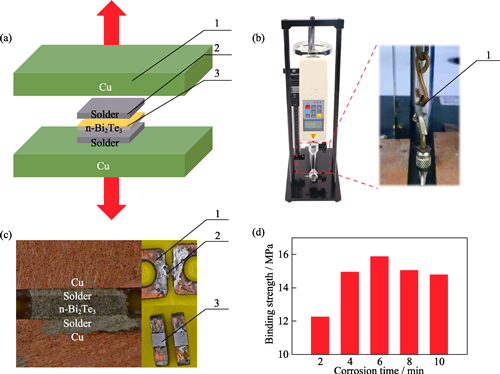
|
|
|
Effect of Recombination Time on the Structure and Properties of P2O5-Al2O3 Heterogeneous Composite Glass
ZHU Qingong, ZHAO Gaoling, HAN Gaorong
2023 Vol. 38 (2): 170–176
 Abstract
Abstract(
273 )
 HTML
HTML(
9)
 PDF
PDF(4732KB)(
372
)
In recent years, phase separation glass has attracted extensive attention because of its unique structure and excellent properties. But its mechanism of phase separation on glass remains insufficient clear, especially, the influence of recombination time on structure and properties is unclear. Here, strengthened P2O5-Al2O3 glass with SiO2-Na2O high-silicate glass particles as the second phase was prepared by melting-quenching method combined with pneumatic atomization and mechanical stirring. The relationship between structure and mechanical properties of the glass was investigated by varying the recombination time. Experiment results showed that Young's modulus of the heterogeneous composite glass was higher than that of the P2O5-Al2O3 glass. Young's modulus of the sample firstly increased and then decreased with the recombination time increasing from 10 s to 8 min. The highest Young's modulus of 80.7 GPa was obtained at recombination time of 6 min, which was increased by 18% as compared with the P2O5-Al2O3 glass. Introducing SiO2-Na2O high-silicate glass particles not only formed the second phase in the matrix glass, but also changed the structure of the P2O5-Al2O3 glass. As the recombination time increases from 10 s to 6 min, coordination number of phosphorus in heterogeneous composite glass network gradually increases, while amount of non-bridging oxygen in the glass network gradually decreases, resulting in a gradual increase in network cross-linking. However, when the recombination time is more than 8 min, it is not conducive to network crosslinking. Therefore, development of heterogeneous composite glass can provide a new route for the preparation of glass materials with good damage resistance.

|
|
|
Tensile Creep Behavior of Cansas-II SiCf/SiC Composites at High Temperatures
JING Kaikai, GUAN Haoyang, ZHU Siyu, ZHANG Chao, LIU Yongsheng, WANG Bo, WANG Jing, LI Mei, ZHANG Chengyu
2023 Vol. 38 (2): 177–183
 Abstract
Abstract(
865 )
 HTML
HTML(
29)
 PDF
PDF(1991KB)(
555
)
Continuous silicon carbide fiber reinforced silicon carbide composite (SiCf/SiC) is a key material for the advanced aero-engines. It is required to possess excellent high-temperature creep resistance for SiCf/SiC to meet the long-term service lifetime of the aero-engines. Here, tensile creep behaviors of a plain woven Cansas-II SiCf/SiC (2D-SiCf/SiC) were investiged in the temperature of 1200-1400 ℃ with the stress levels of 80 to 140 MPa. Its microstructure and fracture morphology were observed, and composition was analyzed. Results show that creep-rupture time of 2D-SiCf/SiC is more than 500 h and steady-state creep rate is 1×10-10-5×10-10 /s at stresses lower than the proportional limit stress (σPLS). The creep behaviors are controlled by matrix and fibers. The creep-rupture time is significantly reduced, and the steady-state creep rate is increased by an order of magnitude when the stress is higher than the σPLS. The matrix, fibers and interfaces of the composite are greatly oxidized, and the creep behaviors are mainly controlled by the fibers.
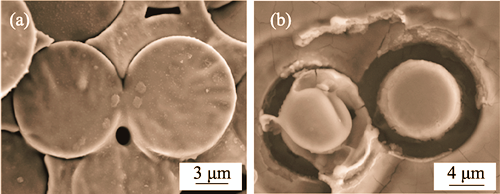
|
|
|
Effects of Carbon Sources on Structure and Properties of TaC Ceramic Powder Prepared by Polymer Derived Ceramics
SUN Jingwei, WANG Honglei, SUN Chuhan, ZHOU Xingui, JI Xiaoyu
2023 Vol. 38 (2): 184–192
 Abstract
Abstract(
390 )
 HTML
HTML(
13)
 PDF
PDF(8717KB)(
716
)
Polymer derived ceramic is one of the effective methods for producing ultra-high temperature ceramics and powders, but effect of source material type on precursor cross-linking degree and ceramic yield has rarely been reported. Here, TaC precursors were synthesized using two carbon sources and poly-tantalumoxane (PTO). Phase composition and microstructure of TaC ceramic powders from different carbon sources, tantalum/carbon mass ratios, and pyrolysis temperatures were characterized. It was found that PF-3 resin with C=C was effective in promoting the cross-linking of PTO and increasing the ceramic yield. When the mass ratio of PTO to PF-3 Resin was 1 : 0.25 and PTO to 2402 Resin was 1 : 0.4, TaC ceramic powders could be obtained at 1400 ℃ without residue Ta2O5. Ceramic yields of ceramic powders were 54.02% and 49.64%, and the crystal sizes were 47.2 and 60.9 nm, respectively. Therefore, PF-3 resin is able to reduce crystal size while increasing ceramic yield, but has less impact on the powder purity and particle size. The purity of TaC ceramic powders derived from different carbon sources are 96.50% and 97.36%, respectively, meanwhile the median diameters are 131 and 129 nm, respectively.
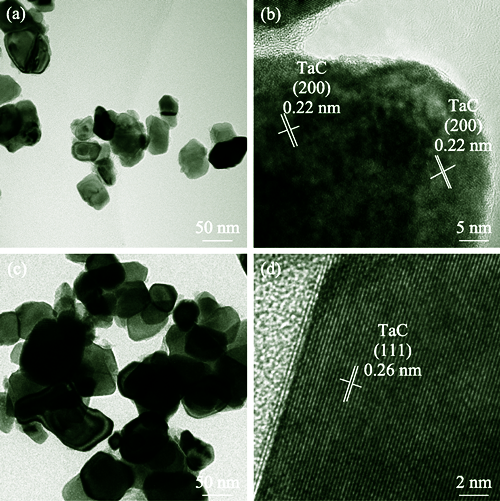
|
|
|
Fabrication of Transparent AlON by Gel Casting and Pressureless Sintering
JIN Xihai, DONG Manjiang, KAN Yanmei, LIANG Bo, DONG Shaoming
2023 Vol. 38 (2): 193–198
 Abstract
Abstract(
421 )
 HTML
HTML(
25)
 PDF
PDF(4293KB)(
530
)
Transparent AlON possesses good mechanical and optical properties, which shows great potential for application. However, high fabrication cost seriously restricts its wide usage. To solve this problem, gel-casting and pressureless sintering of transparent AlON was tentatively studied here, with emphasis on low temperature synthesis and anti-hydrolysis treatment of AlON powder. It was found that fine AlON powder could be readily synthesized at a low temperature of 1700 ℃ by a novel carbothermal nitridation technique, using polymer coated AlN/Al2O3 mixture as the starting materials. The powder obtained was submicron in size and its hydrolysis resistance could be significantly improved after surface coating with a polyurethane layer. On the basis of these findings, transparent AlON ceramics was successfully prepared through gel-casting and pressureless sintering. The material sintered at 1850 ℃ showed good optical and mechanical properties, with a high in-line transmittance of 83.1%-86.2% from ultraviolet to mid-infrared and three-point bending strength of 310 MPa.

|
|
|
YBa2Cu3O7-δ Thin Film: Preparation by BaCl2/BaF2-MOD Method and Superconducting Property
CHEN Mingyue, YAN Zhichao, CHEN Jing, LI Minjuan, LIU Zhiyong, CAI Chuanbing
2023 Vol. 38 (2): 199–204
 Abstract
Abstract(
338 )
 HTML
HTML(
3)
 PDF
PDF(2817KB)(
430
)
Conventional trifluoroacetic acid metal organic chemical solution deposition (TFA-MOD) method for the preparation of YBa2Cu3O7-δ (YBCO) superconducting layers follows the BaF2 growth mechanism. In this work, a novel chemical solution method based on BaCl2/BaF2 pathway for the growth of YBCO superconducting thin films was carried out. The effects of Cl addition on grain orientation, microstructure and superconductivity of YBCO thin films were investigated, and mechanism of the phase transition of YBCO thin films in the BaCl2 pathway was explored by thermochemical calculations of the growth reaction. The results show that the Cl addition inhibits a-axis grain orientation and promotes nucleation of c-axis grains. Onset transition temperature (Tc-onset) of the YBCO 2-layer film is about 89.6 K without significant change after Cl addition. But its critical current density (Jc) is significantly increased to 2.07 MA/cm2 (77 K, self-field). Meanwhile, the phase transition of the growth reaction process shows that Cl is preferentially combined with Ba to form BaCl2 as much as possible, effectively avoiding the formation of BaCO3. All results of this study indicate that Cl addition facilitates preparation of YBCO superconducting thick films, and provides a new idea for the preparation of YBCO by MOD method.

|
|
|
Prussian Blue Modified Biochar: Preparation and Adsorption of Ammonia Nitrogen from Sewage
YU Yefan, XU Ling, NI Zhongbing, SHI Dongjian, CHEN Mingqing
2023 Vol. 38 (2): 205–212
 Abstract
Abstract(
664 )
 HTML
HTML(
29)
 PDF
PDF(1233KB)(
674
)
Eutrophication caused by nitrogen, phosphorus and organic pollutants is a common problem which has attracted much attention in China. Ammonia nitrogen, as a main pollutant, should be removed efficiently to avoid the extension of eutrophication. In this research, Prussian Blue (PB), which can not only capture ammonia nitrogen by vacancy in crystal cell but also degrade organic pollutants by Fenton oxidation, was combined with modified biochar to increase efficiency of ammonia nitrogen removal. Several characterization methods were used to investigate the structure and morphologies of the biochar composite. Adsorption capacity of biochar composite material (BC700-PB) was tested by NH4Cl solution. The results show that the maximum adsorption capacity to ammonia nitrogen is 24.4 mg/g and the removal efficiency is over 95% within 60 min under the condition of pH 8, which is 101.3% higher than that of the unmodified biochar. The adsorption mechanism of BC700-PB was investigated with Langmuir model and pseudo-second-order kinetic equation which reveal that the adsorption including physical adsorption by biochar and coordination adsorption by PB. Meanwhile, Fenton oxidation process is conducted by PB nanoparticles in the biochar composite material with existence of H2O2. The biochar composite material could catalyze H2O2 to generate •OH, and achieve degradation of organic pollutants and adsorption of ammonia nitrogen. The PB/biochar composite material can be recycled easily by NaCl solution for several times. In conclusion, the PB/biochar composite is a promising material for eliminating multi-component eutrophication wastewater.

|
|
|
Zirconia Spacer: Preparation by Low Temperature Spray-coating and Application in Triple-layer Perovskite Solar Cells
ZHANG Wanwen, LUO Jianqiang, LIU Shujuan, MA Jianguo, ZHANG Xiaoping, YANG Songwang
2023 Vol. 38 (2): 213–218
 Abstract
Abstract(
651 )
 HTML
HTML(
138258)
 PDF
PDF(5027KB)(
623
)
Perovskite solar cells (PSCs) with structure of TiO2/ZrO2/carbon triple-layer are attractive recently because of their inexpensive raw materials, scalable fabrication process, and outstanding stability. But little progress has been made in the low temperature fabrication of TiO2/ZrO2/carbon triple-layer structured PSCs. A major reason is that it is rather difficult to construct the ZrO2 spacer layer at low temperature. Herein, we report a facile low-temperature spray-coating method to prepare effective ZrO2 spacer layer in TiO2/ZrO2/carbon triple-layer PSCs using urea to tune the porosity. After optimizing the amount of urea and the thickness of zirconia to 1100 nm, power conversion efficiencies (PCE) of 14.7% for a single cell and 10.8% for a module with 5 cells connected in series (5×0.9 cm× 2.5 cm) were achieved. Furthermore, the PSCs could be stable for 200 d at constant temperature (25 ℃) and humidity (40%). With this spray coating method, the zirconia layer on flexible substrate can endure 50 times of bending without any cracking. Compared to the conventional screen-printing method of ZrO2 spacer layer, the spray-coating alternative developed in this work shows advantages of more convenient to process, preparation under lower temperature, and compatibility to flexible substrate.

|
|
|
Irradiation Damage of CaF2 with Different Yttrium Concentrations under 193 nm Laser
WANG Huajin, KOU Huamin, WANG Yongzhe, JIANG Dapeng, ZHANG Bo, QIAN Xiaobo, WANG Jingya, ZHU Linling, ZENG Aijun, YANG Qiuhong, SU Liangbi
2023 Vol. 38 (2): 219–224
 Abstract
Abstract(
490 )
 HTML
HTML(
16)
 PDF
PDF(3312KB)(
424
)
Radiation resistance of CaF2 crystal is one of the critical properties in the application of deep ultraviolet lithography, but the damage process under 193 nm laser irradiation is still unclear. This paper reports the damage behavior of CaF2 crystals under 193 nm laser irradiation and the key defect factors affecting the damage. Through the 193 nm laser irradiation experiment, it is found that the crystal damage is mainly manifested as the radiation-induced color centers inside the crystal and the radiation-induced damage pits on the surface. Irradiation-induced color centers were analyzed by UV-visible spectrophotometer, and linear fitting was performed between absorption coefficients of different color centers and Y impurity contents. The results show that Y ion has a low-order orbit that overlaps with the F center structure wave function, and hybridizes to form a stable structure. There is a linear relationship between Y ions contents and intrinsic color centers of CaF2 crystals, confirming that Y element is the key impurity ion affecting the formation of color centers. Energy dispersive X-ray spectrometer (EDS) results show that the content of calcium in the damage pits increases and the content of fluorine decreases, which confirms that the diffusion of H centers and the aggregation of F centers lead to irradiation damage. Electron backscatter diffraction (EBSD) results show that surface irradiation damage occurs preferentially at dislocations. Therefore, reducing the impurity content and dislocation density is an important way to improve the anti-irradiation damage performance of calcium fluoride crystals under 193 nm laser.

|
|